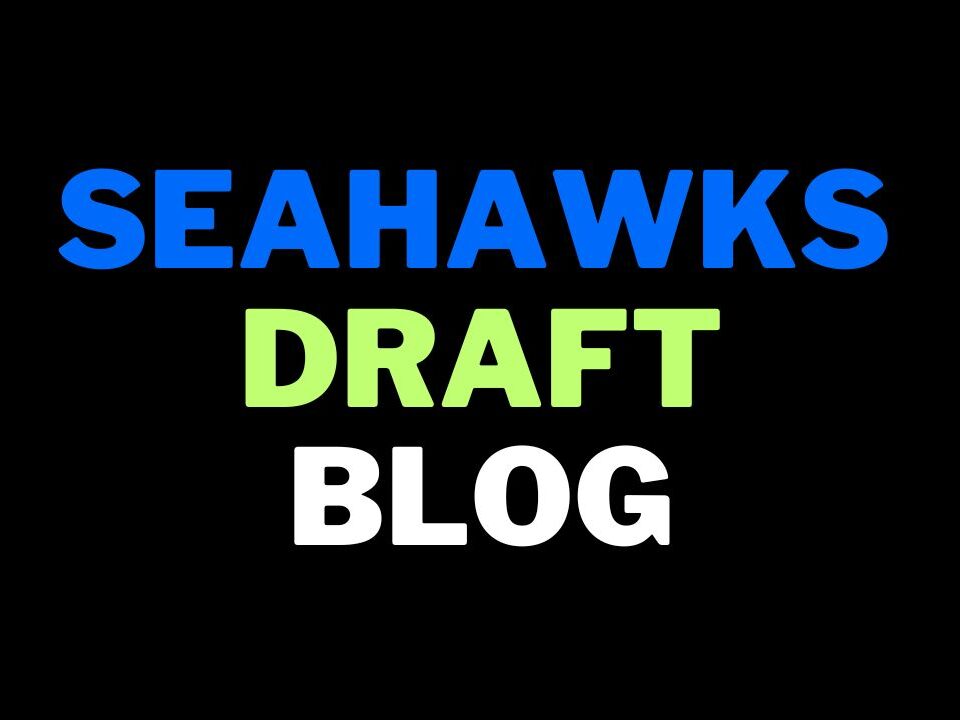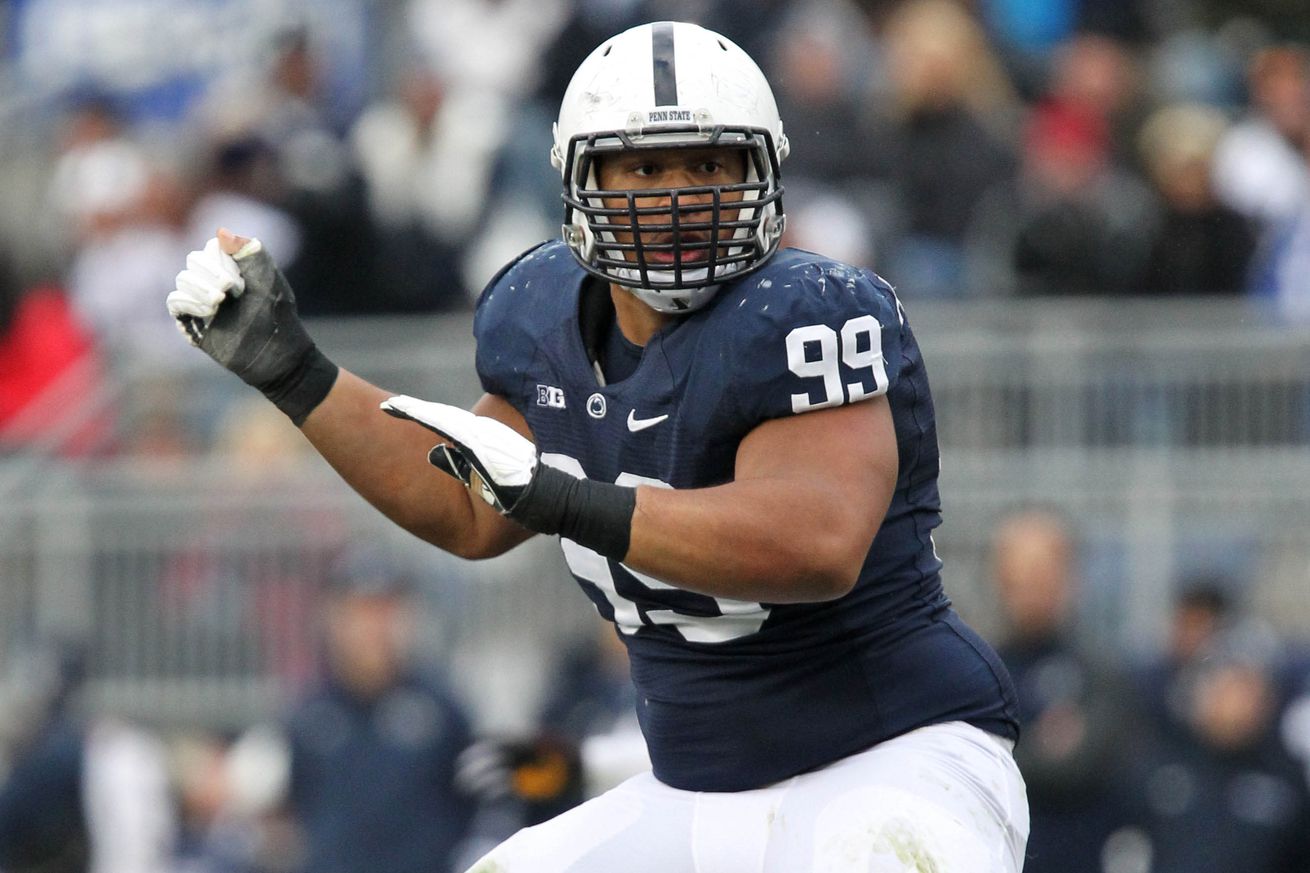
Travis Feeney is one of the few explosive athletes in the draft class
Who is starting at tackle?
This is the first question the Seahawks have to ask. The key to the draft is the future of Russell Okung. With Cordy Glenn getting the franchise tag and reports today that the Raiders are intent to lock up Donald Penn — Okung is probably going to receive a sizeable offer from another team.
Even Mitchell Schwartz is being touted as an $8m APY tackle. The chances of keeping Okung or finding a replacement in free agency appear limited.
But isn’t it a great D-line class?
It’s a very deep class but it lacks more than a handful of exceptional athletes. There will be players you can get at #26 and #56 with similar grades. You can even find a good option in rounds three or four.
Bang the drum for a defensive lineman at #26 if you want. The smarter move is probably to use the depth to your advantage. The depth at offensive tackle is far weaker and if you don’t take one in the first frame — you risk missing out.
So what about this tackle class?
There’s an exceptional chance the top five (Tunsil, Stanley, Conklin, Spriggs and Decker) will be off the board by Seattle’s pick.
Such a scenario would leave three genuine candidates — Shon Coleman, Germain Ifedi and Le’Raven Clark. Coleman didn’t work out at the combine but plays with a tremendous edge, has battled adversity like nobody else in this draft (cancer survivor) and has excellent size/length (6-5, 307lbs, +35 inch arms).
Ifedi gets a bad press in the media but he has incredible upside and the potential to play either tackle spot or left guard. He’s pushing 6-6 and 324lbs with 36 inch arms. This is the profile of a Seahawks offensive tackle based on their draft history.
Ifedi also had the best vertical jump among linemen (32.5 inches) topping even Jason Spriggs despite being 20lbs heavier. He also had one of the top broad jumps (9-1). I wrote about Ifedi back in December. Tony Pauline yesterday reported the Seahawks and Broncos are interested: “Teams were impressed with Germain Ifedi’s workout, and there’s a feeling the Texas A&M offensive tackle could slide into the late part of Round 1. I’m told right now Seattle and Denver are the teams targeting Ifedi late in round one.”
Greg Robinson hasn’t lived up to expectations as a pro but he was considered an athletic monster at the 2014 combine. Ifedi had a superior vertical by four inches, a broad jump that was only three inches shorter and his short shuttle was 0.10 quicker.
Clark had a good workout at the combine and he’s an athletic 6-5, 314lbs with +36 inch arms. Again — size and length is Seattle’s profile. He’s technically poor but has the ceiling of a top-five tackle in the league. A team with a good O-line coach might fancy their chances of turning Clark into a stud.
These three ‘fall-back’ options might not sound all that appealing. The alternative — not taking a tackle and putting Justin Britt back on the right — might be even less appealing.
Coleman, Ifedi and Clark don’t carry anywhere near as much hype as the D-line class but it’s rare to find this combination of length, size and athleticism at offensive tackle in the late first round. To find it in three players? That’s not to be sniffed at.
What about the defensive linemen?
I’m not sure about the talk of needing to go D-line at #26. That’s somewhat missing the point on the class. It’s not that the options in round one are particularly fantastic. It’s the overall depth and quality. There could be +30 prospects carrying grades in rounds 1-3.
Pete Carroll noted to Pat Kirwan that they’re looking for players that can force turnovers. The one big complaint about this deep D-line class is its lack of quick-twitch pass-rushers (edge or interior).
Emmanuel Ogbah can impact plays and had 13 sacks in 2015 — but his motor is wildly inconsistent. The Seahawks spoke to him at the combine and with good reason. Has he got the grit-factor? He and Charles Tapper were the only two D-liners to run an elite 1.5 10-yard split. These two are the most intriguing edge rushers in the class with length (Ogbah 35.5 inch arms, Tapper 34.5 inches) and size (Ogbah 6-4, 273lbs, Tapper 6-3, 271lbs).
Ogbah also had a 35.5 inch vertical, a 10-1 broad jump and a 4.62 forty. Tapper had a 34 inch vertical, a 9-9 broad jump and the quickest forty among D-liners (4.59). They both flash on tape.
According to Bob McGinn’s anonymous source, Ogbah could be available in the late first round. Tapper is likely a second round selection.
If you feel comfortable with Ogbah’s motor and you’re able to find a solution at offensive tackle (or keep Okung) he makes sense at #26.
Jonathan Bullard had a better than expected workout, testing well among potential interior candidates. On tape he looks most comfortable as a five-technique. McGinn’s source suggests he’ll be available in rounds 2-3 and despite his performance in Indianapolis that grade seems pretty accurate. His best fit might be at DE in a 3-4.
There were several disappointing performances including Adolphus Washington and Chris Jones. Kenny Clark likely bolstered his stock with a good performance and looks like an early second round pick as a pure one-technique. Michigan’s Willie Henry could also provide some value — and Javon Hargrave continues to be an intriguing smaller school option.
Seattle drafted Jordan Hill in round three with a 5.23 forty (1.75 split) and a 22.5 inch vertical. He did have a decent 4.51 in the short shuttle. The Seahawks seem less concerned by SPARQ stars on the D-line once they cross the third round threshold. Keep an eye on Washington if he falls into round three — he’s a better pass-rusher on tape than he is a combine warrior.
Two others players are pretty interesting. Shaq Lawson is 6-3 and 269lbs with 33 inch arms. He had a fairly average forty (4.70) but had a fantastic three-cone and short shuttle. His ten-yard split time was 1.64. Carl Nassib is 6-7 and 277lbs with 34.5 inch arms. He ran a nice 1.62 split for his size and a good 4.37 short shuttle and 7.27 three cone. He did only jump 28.5 inches in the vertical though. Both players were productive in 2015 (Lawson 12.5 sacks, Nassib 15.5). Lawson could be a late first or early second round pick. Nassib could go in the third or fourth round.
Cutting down the running back class
Based on the combine workouts there’s really only three options — Derrick Henry, C.J. Prosise and Kenneth Dixon. Henry could be off the board by #26 and probably won’t appeal as a first round candidate. Dixon is being graded in rounds 2/3. Prosise might be available in the late third.
The Seahawks have a definitive size ideal at running back and demand a certain level of athleticism and toughness. Alex Collins (4.59, 28.5 inch vertical) and Paul Perkins (4.54, 32 inch vertical) didn’t really make any waves.
Prosise has the size (6-0, 220lbs), speed (4.48) and explosion (35.5 inch vertical) they seem to like. Dixon isn’t far behind at 5-10, 215lbs with a 4.58 and a 37.5 inch vertical. Both players are useful in the passing game and finish their runs.
Indiana’s Jordan Howard and Utah’s Devontae Booker didn’t workout so we’ll need to see how they test at their respective pro-days.
Round two could be a wildcard
While they might feel obliged to draft the best available offensive tackle at #26, they could have a ton of flexibility at #56.
The D-line class is deep enough to wait until round three if they want to. That could open the door for a receiver (Braxton Miller? Sterling Shepard?) an interior offensive lineman (Christian Westerman? Connor McGovern?) or another position.
The Green Bay Packers consistently draft receivers in round two and the Seahawks have used some of that philosophy with John Schneider. Golden Tate (2010) and Paul Richardson (2014) were both second rounders. They traded up in 2015 to take Tyler Lockett in the early third round.
With some uncertainty over Jermaine Kearse’s retainability, Doug Baldwin being a free agent next year and Paul Richardson’s injury concerns — it wouldn’t be a total surprise if they considered someone like Miller or Shepard in the late second.
What about a defensive playmaker?
The one player I couldn’t get off my mind yesterday was linebacker Travis Feeney. This is a guy who had eight sacks in 2015, has terrific size and length (6-4, 230lbs, 33.5 inch arms) and just exploded at the combine.
Feeney ran a 4.50 with an elite 1.59 split. He also had a 10-10 in the broad jump and a 40-inch vertical. According to Rand Getlin, he was also suffering with a hernia. Imagine if he was 100% healthy?
That’s part of the issue with Feeney — his health. He’s had multiple shoulder surgeries and who knows how he checked out medically in Indianapolis?
If he got the all-clear — he could go much earlier than people expect. In a class lacking genuine explosive athletes with freaky length and size — Feeney is a diamond in the rough. Health permitting, it wouldn’t be a surprise if the Seahawks took him a lot earlier than expected to fill the hole left by Bruce Irvin.
And the interior offensive line?
Missouri’s Connor McGovern is 6-4, 306lbs with 33 inch arms and he put on a show with a 1.72 split, a 33 inch vertical and a 4.65 in the short shuttle. The Seahawks like their Mizzou O-liners and McGovern could easily find himself in Seattle to play guard or center.
South Carolina’s Brandon Shell could be a classic Tom Cable tackle-to-guard convert. He has the size Seattle likes at left guard (6-5, 324lbs) with 35 inch arms. Shell ran a 1.75 split and managed a 30.5 inch vertical.
Michigan center Graham Glasgow also had a good workout posting a 1.76 split and a 4.63 short shuttle (both excellent). He’s 6-6, 307lbs with 33.5 inch arms and nearly 11 inch hands. He’s the definition of gritty and hard-nosed. He’s also almost identical in size to Max Unger (with longer arms).
Cornerback options on day three
The Seahawks quietly have a deep crop of up-and-coming corners. Because of the technique they teach it’s difficult to pick it up and start quickly. Even a veteran like Cary Williams struggled badly with the adjustment.
Tye Smith, George Farmer, Stanley-Jean Baptiste, Mo Seisay, Marcus Burley and Tharold Simon could all compete in camp. There’s also a chance they retain Jeremy Lane and DeShawn Shead will be with the team in 2016.
This looks like another 5th or 6th round job — if at all. We also know the Seahawks like length and size and are unlikely to draft any cornerback with sub-32 inch arms.
Of the list working out today that fit the size criteria, here’s the ones that stand out:
James Bradberry — 6-0, 211lbs, 33 inch arms — 4.50, 36 inch vertical
Deandre Elliott — 6-0, 188lbs, 32 inch arms — 4.55, 41 inch vertical
T.J. Green — 6-2, 209lbs, 32 inch arms — 4.34, 35.5 inch vertical
Deiondre Hall — 6-1, 199lbs, 34.5 inch arms — 4.68, 37 inch vertical
Eric Murray — 5-10, 199lbs, 32 inch arms — 4.50 u, 39.5 inch vertical
Rashard Robinson — 6-1, 171lbs, 32 inch arms — 4.50 u, 35.5 inch vertical
Justin Simmons — 6-2, 203lbs, 32.5 inch arms — 4.62 u, 40 inch vertical
Daryl Worley — 6-0, 204lbs, 33.5 inch arms — 4.66 u, 35.5 inch vertical
Richard Sherman ran a 4.56 with a 38 inch vertical at 6-3, 195lbs. Justin Simmons is the best comparison physically and athletically, although he played safety at Boston College. Some people are ranking Simmons in day two after he beat Byron Jones’ long shuttle time.
Byron Maxwell ran a 4.46 with a 33 inch vertical at 6-0, 202lbs. Daryl Worley is similar physically but ran a much slower time.
Late round or UDFA sleeper?
We’ve talked a lot about Tennessee receiver Marquez North. He burst onto the college scene as a major recruit and just as quickly disappeared. A change of regime, injury and inconsistency led to a disappointing career for the Vols.
North still showed flashes of genuine talent. With the right mentor and pro-coaching he could be a great project for someone. North ran a 4.48 at 6-2 and 223lbs. He has a big catch radius (33.5 inch arms) and had a 35 inch vertical. He also shone in the short shuttle (4.13).



